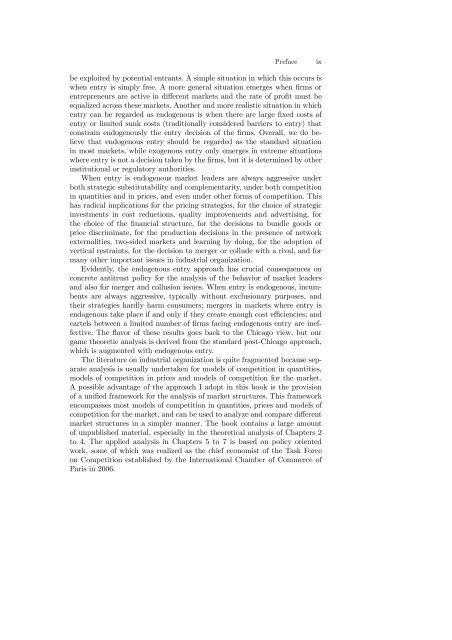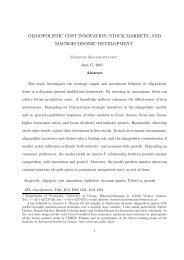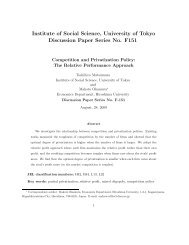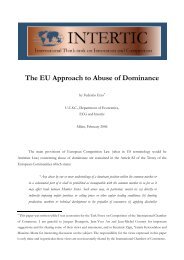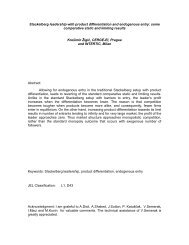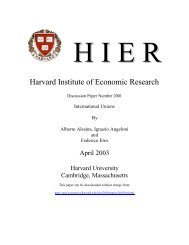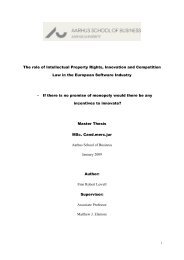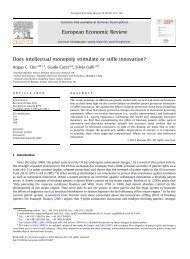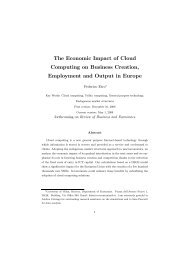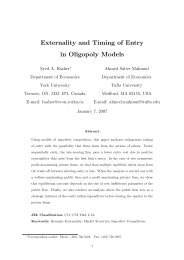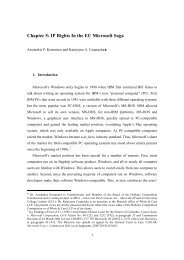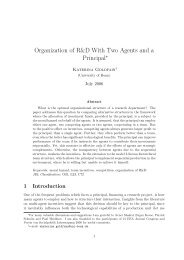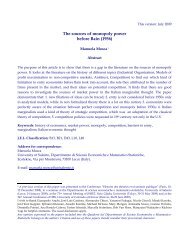Competition, Innovation, and Antitrust. A Theory of Market ... - Intertic
Competition, Innovation, and Antitrust. A Theory of Market ... - Intertic
Competition, Innovation, and Antitrust. A Theory of Market ... - Intertic
Create successful ePaper yourself
Turn your PDF publications into a flip-book with our unique Google optimized e-Paper software.
Preface<br />
ix<br />
be exploited by potential entrants. A simple situation in which this occurs is<br />
when entry is simply free. A more general situation emerges when firms or<br />
entrepreneurs are active in different markets <strong>and</strong> the rate <strong>of</strong> pr<strong>of</strong>it mustbe<br />
equalized across these markets. Another <strong>and</strong> more realistic situation in which<br />
entry can be regarded as endogenous is when there are large fixed costs <strong>of</strong><br />
entry or limited sunk costs (traditionally considered barriers to entry) that<br />
constrain endogenously the entry decision <strong>of</strong> the firms. Overall, we do believe<br />
that endogenous entry should be regarded as the st<strong>and</strong>ard situation<br />
in most markets, while exogenous entry only emerges in extreme situations<br />
where entry is not a decision taken by the firms, but it is determined by other<br />
institutional or regulatory authorities.<br />
When entry is endogenous market leaders are always aggressive under<br />
both strategic substitutability <strong>and</strong> complementarity, under both competition<br />
in quantities <strong>and</strong> in prices, <strong>and</strong> even under other forms <strong>of</strong> competition. This<br />
has radical implications for the pricing strategies, for the choice <strong>of</strong> strategic<br />
investments in cost reductions, quality improvements <strong>and</strong> advertising, for<br />
the choice <strong>of</strong> the financial structure, for the decisions to bundle goods or<br />
price discriminate, for the production decisions in the presence <strong>of</strong> network<br />
externalities, two-sided markets <strong>and</strong> learning by doing, for the adoption <strong>of</strong><br />
vertical restraints, for the decision to merger or collude with a rival, <strong>and</strong> for<br />
many other important issues in industrial organization.<br />
Evidently, the endogenous entry approach has crucial consequences on<br />
concrete antitrust policy for the analysis <strong>of</strong> the behavior <strong>of</strong> market leaders<br />
<strong>and</strong> also for merger <strong>and</strong> collusion issues. When entry is endogenous, incumbents<br />
are always aggressive, typically without exclusionary purposes, <strong>and</strong><br />
their strategies hardly harm consumers; mergers in markets where entry is<br />
endogenous take place if <strong>and</strong> only if they create enough cost efficiencies; <strong>and</strong><br />
cartels between a limited number <strong>of</strong> firms facing endogenous entry are ineffective.<br />
The flavor <strong>of</strong> these results goes back to the Chicago view, but our<br />
game theoretic analysis is derived from the st<strong>and</strong>ard post-Chicago approach,<br />
which is augmented with endogenous entry.<br />
The literature on industrial organization is quite fragmented because separate<br />
analysis is usually undertaken for models <strong>of</strong> competition in quantities,<br />
models <strong>of</strong> competition in prices <strong>and</strong> models <strong>of</strong> competition for the market.<br />
A possible advantage <strong>of</strong> the approach I adopt in this book is the provision<br />
<strong>of</strong> a unified framework for the analysis <strong>of</strong> market structures. This framework<br />
encompasses most models <strong>of</strong> competition in quantities, prices <strong>and</strong> models <strong>of</strong><br />
competition for the market, <strong>and</strong> can be used to analyze <strong>and</strong> compare different<br />
market structures in a simpler manner. The book contains a large amount<br />
<strong>of</strong> unpublished material, especially in the theoretical analysis <strong>of</strong> Chapters 2<br />
to 4. The applied analysis in Chapters 5 to 7 is based on policy oriented<br />
work, some <strong>of</strong> which was realized as the chief economist <strong>of</strong> the Task Force<br />
on <strong>Competition</strong> established by the International Chamber <strong>of</strong> Commerce <strong>of</strong><br />
Paris in 2006.


